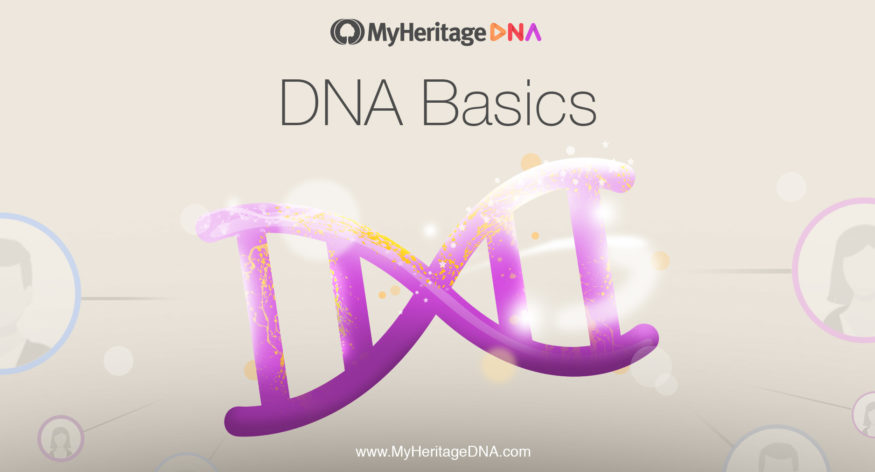

This chapter of DNA Basics is a guest post from Legacy Tree Genealogists about how to make the most of chromosome browsers, like the MyHeritage One-to-Many Chromosome Browser, for genealogical research. This is an exciting tool which can help break through brick walls, grow your family tree, and make the most of your DNA Match list.
Take advantage of our Early Holiday DNA sale going on now! Get MyHeritage DNA at the lowest price of the year!
What is a chromosome browser?
Chromosome browsers are tools that allow you to see the unique DNA segments, or sequences of DNA on chromosomes, shared between you and either one genetic match or a set of genetic matches. It is typically displayed graphically as 23 stripes, representing your 23 chromosomes, with colored sections indicating shared segments. Using a chromosome browser, you can view the start and stop locations of specific shared segments.
Why is a chromosome browser a useful tool for genealogy?
Genetic genealogy, or analysis of DNA test results for the sake of understanding genealogical relationships, is one tool for extending your family tree. It is effective for breaking down brick walls, or dead ends, when you can go no further using conventional methods. Your genetic match list is the best starting point for your genetic genealogy research. Chromosome browsers allow you to view how you share DNA with each of your genetic matches and not just how much total DNA you share. Do you share specific segments of DNA with multiple matches? Are those segments of DNA immediately adjacent to each other? How the DNA is shared between you and your matches can provide more clues that could help you extend your trees and break through your genealogical brick walls.
What are you seeing in the chromosome browser?
You have 23 pairs of chromosomes: one chromosome in each pair was inherited from your mother and the other from your father. While the chromosomes reside tightly twisted in the cell’s nucleus at a microscopic level, if you were to lay them straight against each other, each pair could be arranged from the longest to shortest and numbered 1-23. The last pair of chromosomes are either XX or XY, the sex chromosomes. Some chromosome browsers only show the autosomal pairs, or chromosomes 1-22. Additionally, some chromosome browsers show two stripes for each chromosome pair — one representing the maternal instance and one representing the paternal instance — and others show a single stripe to represent the pair. The MyHeritage Chromosome Browser currently uses the latter, simpler graphical representation with its respective advantages and limitations.
Chromosome browsers show where a genetic match shares DNA with you (or the person whose DNA kit you manage that you are analyzing). If you compare a parent and a child in a chromosome browser that shows a separate stripe for every instance of the chromosomes, the image will show a single continuous colored stripe for each of the chromosomes inherited from the same parent. If the chromosome browser shows only one stripe to represent each chromosome pair, every stripe will be colored, nearly in its entirety, and will appear to be a 100% match, even though it is in fact a 50% match because indeed, one entire chromosome in every pair was inherited from each parent.
Parent-child and identical twin comparisons are the only ones that will show continuous shared DNA segments on all chromosomes. Other than these relationships, the amount of DNA shared in common varies due to a random process called recombination which shuffles the DNA each generation and breaks up segments of shared DNA. For example, the two chromosomes in each pair inherited from a person’s mother, break and recombine before being passed on to the child. Therefore, the maternal chromosome within each pair that the child inherits, will include some of the child’s maternal grandmother’s DNA and some of the child’s maternal grandfather’s DNA. For more information about recombination, including a diagram of how recombination affects the inheritance of chromosomes, see DNA Basics Chapter 5: A Glossary of Terms.
If you compare maternal first cousins in a chromosome browser, only the segments they share, inherited from a common ancestor, will be colored. Perhaps you inherited a longer piece from one grandparent than your first cousin did: the colored region is only the shared DNA is shared. Similarly, your second cousins will have inherited some segments in common from each of your shared great-grandparents, some of which are uniquely inherited only by them and some of which are inherited in common with you and other genetic cousins.
How is this information genealogically useful?
Each of your segments was inherited from one of your ancestors. By comparing shared segments of genetic matches through chromosome browsers, you can make conclusions about which ancestors you have in common and how you are related. Some of those conclusions can even lead to a breakthrough in your genealogical research by allowing you to trace back exact relationship paths in cases where documentation is not available.
- Segment length: Longer segments, often combined with additional smaller segments, indicate a more recent relationship between you and your genetic matches. Many short segments, when the estimated relationship is expected to be a closer match, may indicate that the shared DNA between you and your match comes from an endogenous community or multiple distant common ancestors. Perhaps you and trying to determine which of your fourth to sixth cousin matches are actually the most closely related to you. Examine the segment lengths and those with larger segments are probably more closely related than others with only small common segments.

Comparison of second cousins in the MyHeritage Chromosome Browser, showing segment lengths expected for the relationship
- Matches descended from other matches: We frequently encourage family members to take DNA tests and so it is very common to find descendants of matches within a match list. If one of your matches shares only equal and smaller segments with you than another match, at the same genomic positions, the first match may be a descendant of the second match. If you determine two genetic matches are likely father-son, you can then focus only on the father’s shared DNA, as the son only inherited half of his father’s DNA and therefore is not as genetically useful. If you are attempting to reach the father to collaborate and ask about family stories, you can reach out to the son in hopes that he can connect you with his father.
- Triangulated segments: If you and two matches share a segment (inherited from a common ancestor or ancestors), then you have a triangulated segment. There are several online tools that assist in this triangulation analysis. Each company’s chromosome browser may display the triangulated segments differently. For instance, if you have selected multiple people to compare, it may be that only the triangulated segments across all compared matches will be shown. In the MyHeritage Chromosome Browser, triangulated segments are framed. Be systematic about your comparisons to ensure no triangulated segments are overlooked. Identify the start and stop locations for the shared segment across all of the members of the triangulated comparison set. Use triangulated segments to determine how your genetic matches are related to you. Perhaps you are wondering if a genetic match is a maternal or paternal match: Compare their DNA segments in common with you and other matches whose relationship is known to you, and if they share with others in the same place, you can determine from which line they descend.

In the frame, a triangulated DNA segment shared in common between a root person and 3 of his or her genetic matches; colored segments outside of the frame are shared between the root person and at least one genetic match, but not by the entire comparison set
- Triangulated groups (“cluster”): Those with whom you share triangulated segments can be placed in a triangulated group, or cluster, and together you can work to determine if your overlapping segments can be traced to a specific common ancestor. It is most helpful to have genetic matches in this triangulated group at each step of the way to the common ancestor. For instance, if you have a 3x great-grandparent, attempt to include a cousin, second cousin, third cousin, and fourth cousin from your direct line. This will help to confirm the validity of your triangulated group and identify with certainty your common ancestor.
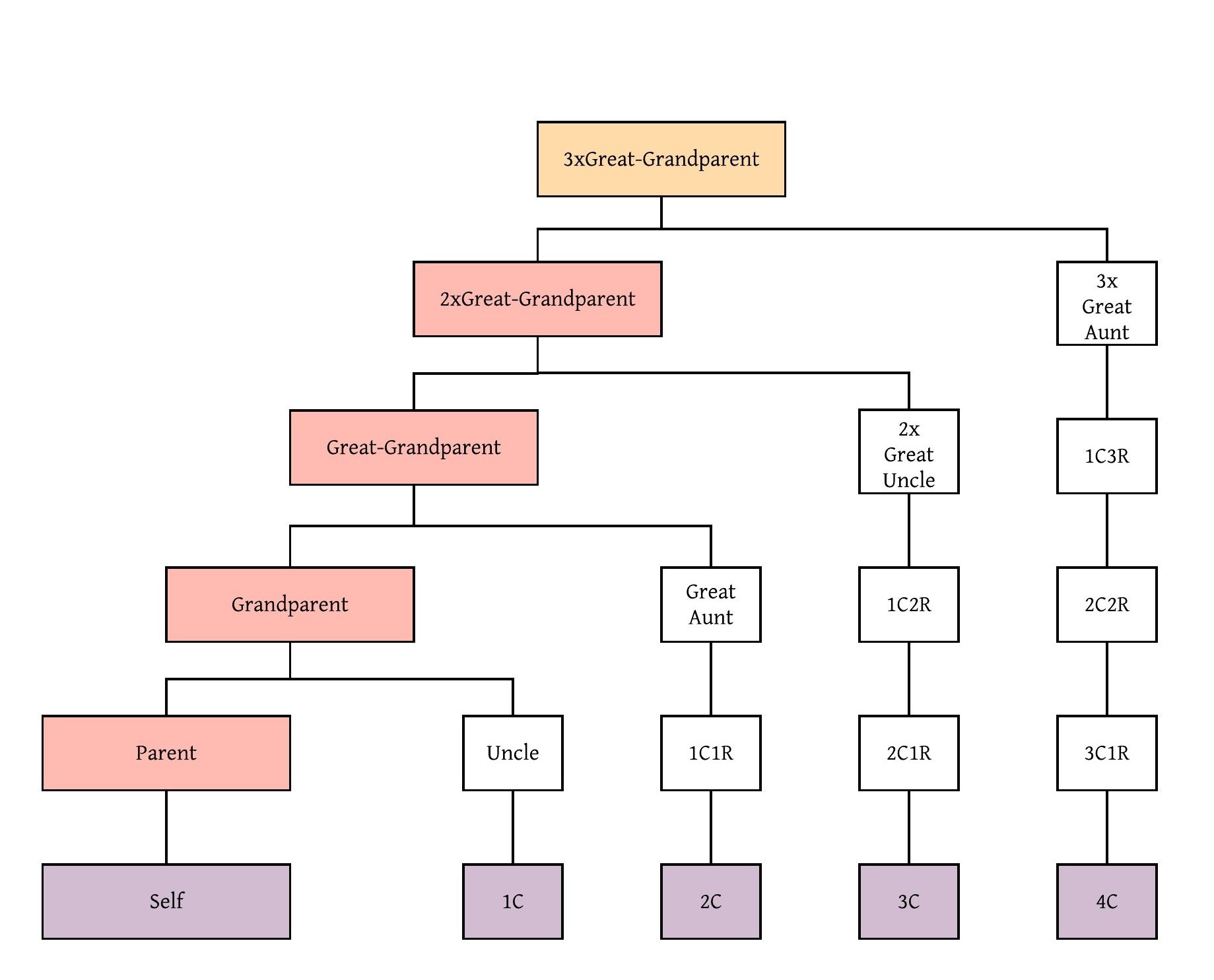
Ideal relationships to include for a triangulated group identifying segments related to a 3x great-grandparent
- Chromosome mapping: With enough shared segments among different close cousins, you can assign specific segments to known ancestors. To know which segments are inherited through your maternal grandfather versus which segments are inherited through your maternal grandmother, you would group and triangulate the segments with close cousins and collateral relatives of those individuals comparing shared segments. With enough shared segments among different close cousins, you may even be able to identify the crossover points for your ancestral segments. Your inheritance can be mapped on a chromosome map, showing from which ancestors your segments of DNA were inherited. This map assists you when comparing new and unknown genetic cousins to determine their likely relationships. If they consistently match in the same regions previously assigned to a particular ancestor, you can hypothesize that they also descend from that mapped ancestor or an ancestor of that mapped ancestor.
- Overlapping opposite segments: If, when comparing two matches separately in a chromosome browser, they each match you at the same location on a chromosome, but do not share that same segment with each other, this is because one is related through your maternal ancestry and one is related through your paternal ancestry. If you think two matches are related through your mother and yet they have shared segments, you can then know that you inherited DNA in common with one match through your mother and you inherited DNA in common with the other match through your father. This does not mean that the two matches aren’t also in some way related, as is common in intermarrying communities.

Paternal match in red and maternal match in yellow, showing overlapping opposite segment on chromosome 13. Note the segments are in the same genomic location but they are not triangulated
- Immediately adjacent segments: If a genetic match on the chromosome browser shows a segment that stops immediately adjacent to another match’s start of a new segment, it is likely that they are related on the same side of your family (either both maternal or both paternal), possibly even diverging at your most recent ancestral couple, with one as the relative of the mother and the other as the relative of the father. This is because as recombination occurs, the break in the chromosomes after they exchange information rotates between the maternal and paternal chromosome. We call this crossover point a recombination point. If you have one match who is a known match through your father’s line and another match with an unknown relationship, and the two show immediately adjacent segments in comparison to your DNA, it is likely both are related through the same line.
Immediately adjacent segments, comparing between self and two maternal genetic matches.
Get started
The best way to understand the Chromosome Browser is to begin using it. Start with any known relationships between you and those in your genetic match list and become familiar with appropriate segment length for known relationships, identify your immediately adjacent segments, triangulated segments, and form triangulated groups (clusters) of matches. Perhaps you will enjoy your chromosome puzzle and will decide to map your chromosomes to your furthest genetically confirmed ancestors.
 Legacy Tree Genealogists is the world’s highest client-rated genealogy research firm, and recommended research partner of MyHeritage. Founded in 2004, the company provides full-service genealogical research for clients worldwide, helping them discover their roots and personal history through records, narratives, and DNA. For more information on Legacy Tree and their services, visit: www.legacytree.com
Legacy Tree Genealogists is the world’s highest client-rated genealogy research firm, and recommended research partner of MyHeritage. Founded in 2004, the company provides full-service genealogical research for clients worldwide, helping them discover their roots and personal history through records, narratives, and DNA. For more information on Legacy Tree and their services, visit: www.legacytree.com
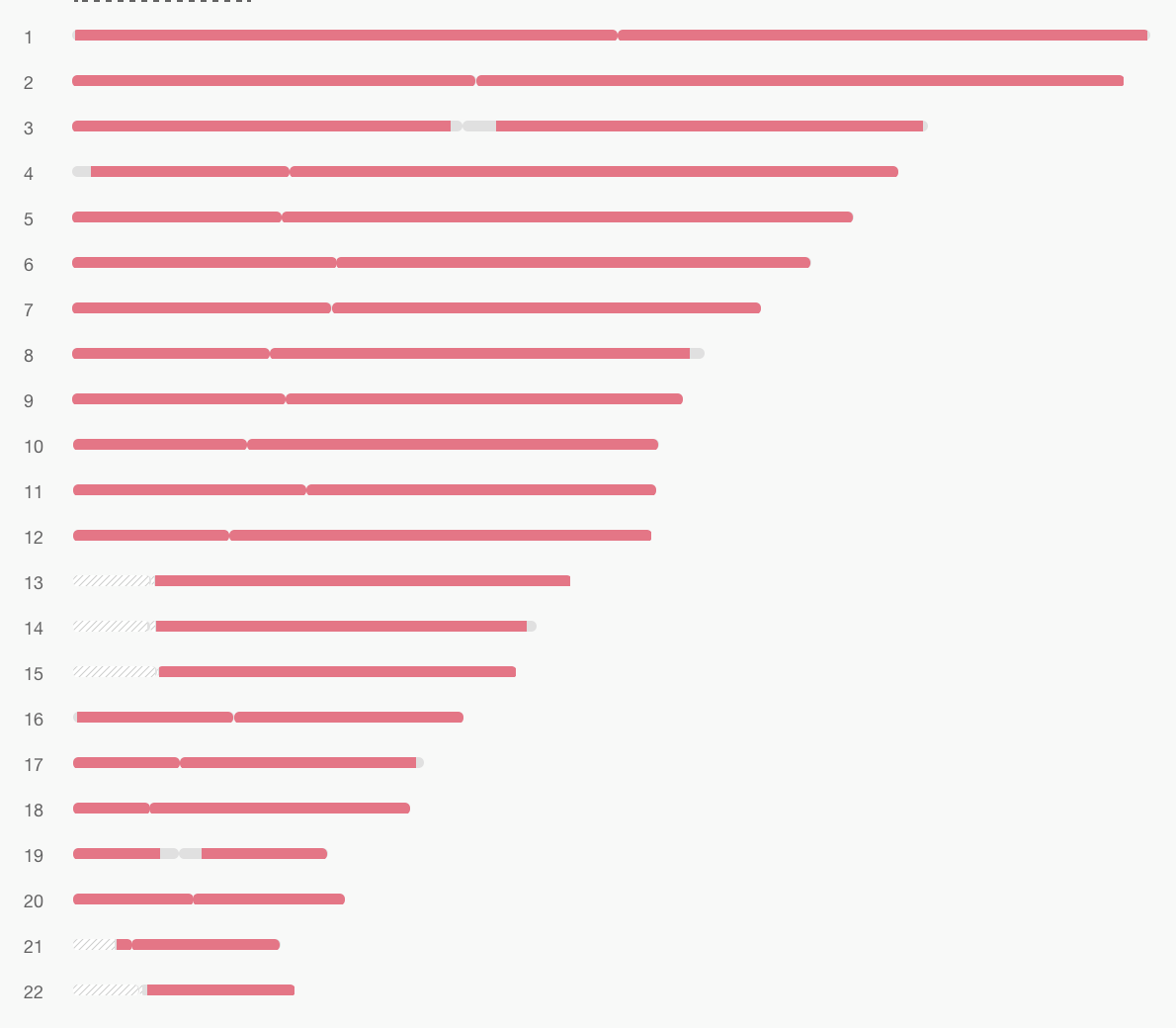
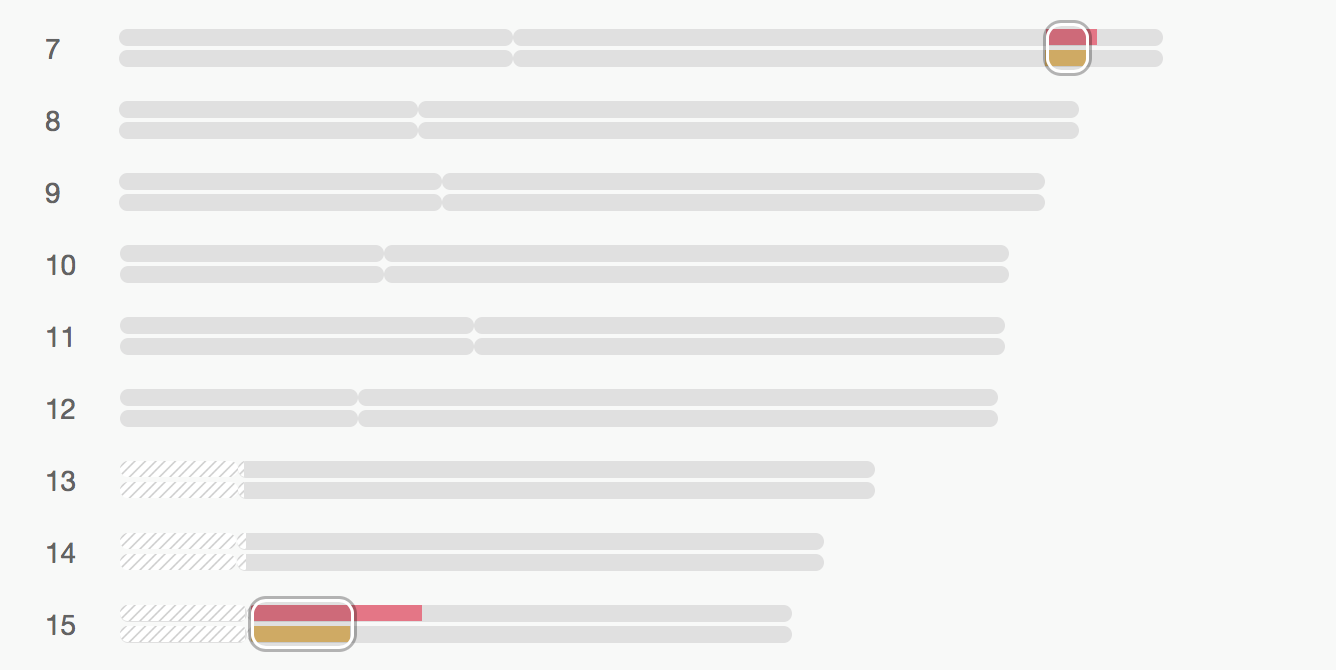


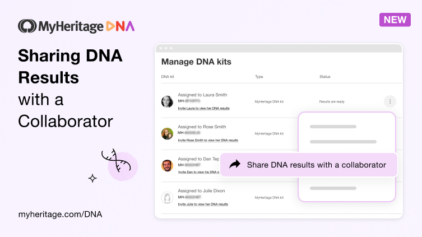
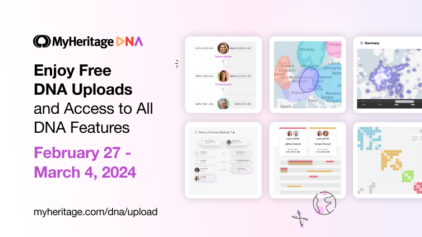
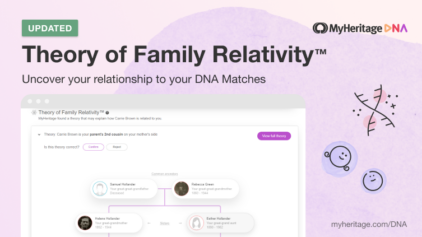
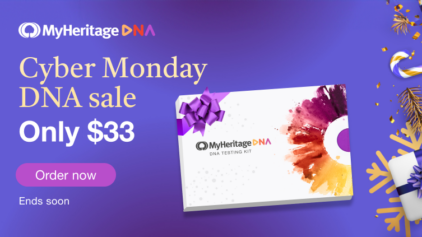
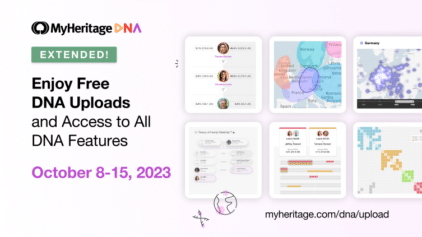
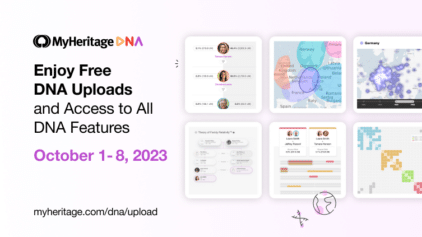
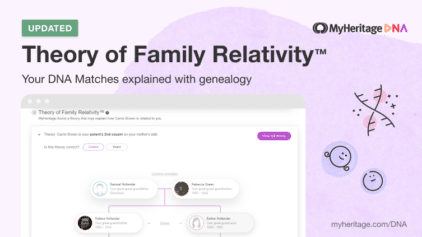

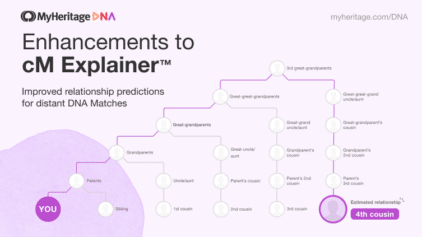
Phillip Moon
June 25, 2018
I have a rare anti-body that less than 1% of the world population carries. Cancer research are trying to figure out how we are all related or connected someway!